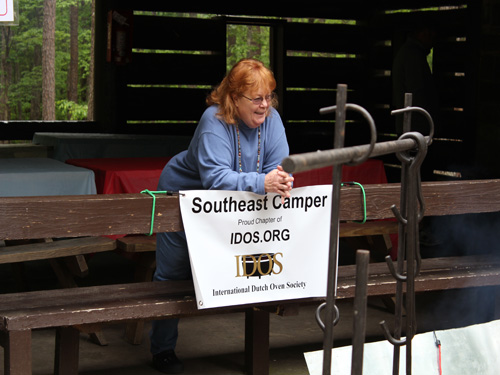Cooking with Charcoals
Where do I put them?
Well, that depends on what you’re cooking and after some time you will do it without thinking about it. Do not be scared, it will start to come naturally.
The rule of thumb is 2 times the diameter of your Dutch oven:
If you are using a 12″ Dutch oven you would start with 24 briquettes. Then divide it back by two to have two amounts 12 and 12. Then take two from one and add to the other for a group of 10 and 14. Use 10 on the bottom and 14 on top of your oven for general cooking. Remember this is just a rule of thumb for starting. If you are frying foods then add more to the bottom. If you are baking add more to the top. Then by adding and subtracting briquettes is just like turning the heat up and down on your oven at home.
If you are frying bacon or meats start with 8 or 10 coals underneath and add more if needed. Lay the coals out in a circle evenly spaced with the oven legs with two or three spaced in the center. After a short while give the oven a quarter turn to spread the heat evenly. The coals could be laid out in a checkerboard pattern or what ever suits you’re fancy. Have fun with it. When sautéing remove a few charcoals after you have the heat you need for a slower, lower cooking temperature.
For baking it is different, lay out about 4 to 6 coals the same as above, then lay coals side by side around the rim of the lid and a few in the middle next to the handle. While baking spin the lid a quarter turn and the entire oven a quarter turn for even heat distribution. When cooking biscuits or breads they can be put right on the bottom of the oven. When cooking something like stuffing, which has more moisture a few more coals could be added to the bottom, but be careful. As for pie it is best to bake it in a pie tin and on a trivet staying off the bottom and it will bake more like your oven at home.
The following is not etched in stone, but is a good starting point:
Quantity of charcoal = 2 times the Diameter of the Dutch oven = 325º ±. With each additional charcoal adds 10-15º to Cooking Temperature.
Bake = coals in rings 2:1 ratio top over bottom
Stew or Simmer = coals split evenly
Broil = coals in checkerboard 2:1 ratio top over bottom
Fry or Boil = all coals on the bottom
Of course the number of briquettes used will vary depending on the size of your Dutch oven, more for a big 16 incher and one or two for a 5 incher.
The Dutch Oven lid can be used as a griddle if turned over, use a lid stand turned over to accommodate the lids handle. Then place coals / briquettes underneath and cook away. It can be used for scrambling eggs, pancakes, French toast, bacon and more. The advantage of this is that the lid is slightly bowl-shaped, so
even if it is not level your food will not run out.
 Stack cooking is the practice of stacking your Dutch ovens one on top of another, starting with the largest to the smallest and cooking a different item in each one. This conserves fuel, but you must be careful. The disadvantage of stacking is that if the bottom oven needs to be checked, all the Dutch ovens on top of it must be moved first. It make a good site and everyone will be amazed.
Stack cooking is the practice of stacking your Dutch ovens one on top of another, starting with the largest to the smallest and cooking a different item in each one. This conserves fuel, but you must be careful. The disadvantage of stacking is that if the bottom oven needs to be checked, all the Dutch ovens on top of it must be moved first. It make a good site and everyone will be amazed.
In my world lighter fluid is a NO-NO!
I use a chimney starter to get my charcoal briquettes started.  All you need is old newsprint, roll the paper from the edges towards the center like you were making a pillow and put in bottom of chimney. Then add the desired amount of briquettes plus a few spares and light the paper. If it’s windy or your briquettes are damp add a small amount of vegetable oil to your paper. If you are cooking a dish that will take longer than 1 to 1½ hours, put a few briquettes in the chimney, add one or two hot coals, then top off with more and you can keep coals going all day.
All you need is old newsprint, roll the paper from the edges towards the center like you were making a pillow and put in bottom of chimney. Then add the desired amount of briquettes plus a few spares and light the paper. If it’s windy or your briquettes are damp add a small amount of vegetable oil to your paper. If you are cooking a dish that will take longer than 1 to 1½ hours, put a few briquettes in the chimney, add one or two hot coals, then top off with more and you can keep coals going all day.
Remember, if you have a chimney starter, charcoal and paper you can cook anywhere and no messy fluids the tote around.
Dan & Katherine

